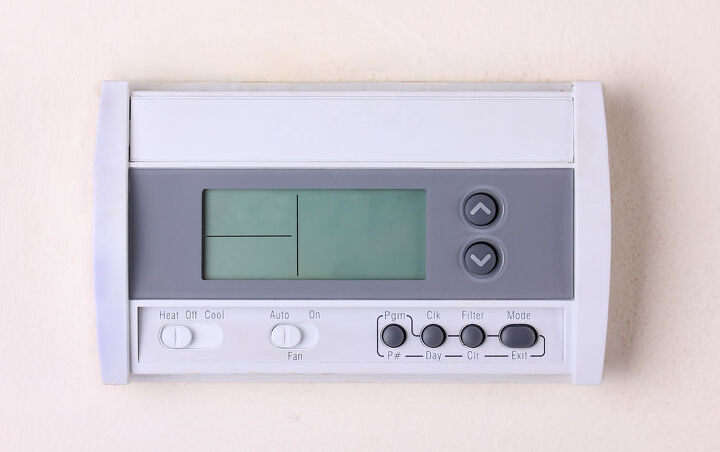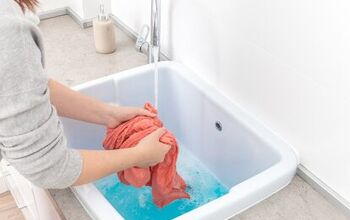Thermostat Goes Blank Then Comes Back On? (Fix It Now!)

Thermostats act as the heart of every home’s AC system, but that doesn’t mean they don’t get glitchy. A common issue that you might have with a digital thermostat happens when your thermostat’s face suddenly goes blank, then turns back on. It’s almost like a reboot…except it’s not supposed to happen. If this happens to you, you might be wondering what this means for your HVAC system.
A thermostat that turns off, then quickly turns on soon after is a sign of short cycling. Short cycling occurs when there’s an issue with your heating system that prevents airflow. This can be caused by dirty filters, a tripped float switch, a tripped circuit breaker, bad wiring, a bad thermostat, or a refrigerant leak.
Short cycling isn’t just a nuisance that makes it hard to keep your house warm. It’s a sign that something is quite seriously wrong with your home’s HVAC system. This guide will help you understand the basics.
Do You Need Your Thermostat Repaired or Reprogrammed?
Get free, zero-commitment quotes from pro contractors near you.

Troubleshooting A Thermostat That Keeps Turning Off And On
So, it’s clear that something is not quite right with your thermostat. If things were kosher, then you wouldn’t have it turning on and off in small bursts. But, what does this mean for your troubleshooting? Here’s what you’re going to need to do to discover most of the potential causes dealing with your thermostat…
- Start by changing out (or at least checking) your air filters. If your air filters are dirty, then you will need to replace them. This could be the reason why you have short cycling altogether. It’s a surprisingly easy fix, isn’t it? With most cases of short cycling, this will greatly improve your results or fix it altogether.
- Next, check your circuit breaker. If the breaker is tripped, turn it back on again. It could have been an overloaded circuit, and it could just be a one-off issue. If you notice that it’s a regular occurrence, check out what a circuit breaker that keeps tripping without anything plugged in could be.
- Add new batteries to your thermostat. Though it’s rare, some models have been known to start short cycling due to low power. Change the batteries and see if the short cycling continues. If it doesn’t, you have your fix.
- Then, check the float switch. The float switch is the item in your thermostat that detects moisture, and sometimes, it can go bad. If it does, it’ll falsely register moisture in the air and that will cause your thermostat to stop working. You can usually use a voltmeter to test this. If it’s bad, replace it.
- Once you’ve checked the float switch, take a look at your AC unit’s refrigerant. If you notice a refrigerant leak, then you will need to patch this up. A refrigerant leak could cause your thermostat to glitch out, not to mention cause ice to form around your unit or even have a compressor blow.
- After that, take a look at the circuitry leading up to your thermostat. Remember when we mentioned that a lack of power to your thermostat could be a cause for short cycling? Well, this could be a reason why.
- Finally, consider replacing your thermostat. If your thermostat is over the age of 10, there’s a good chance that what you’re dealing with is a bad thermostat. After a certain point, thermostats go bad and they’re in need of replacement. If your thermostat still isn’t working properly after you’ve changed the batteries and everything, it’s time to get a new one.
Could This Be A Furnace Issue?
Potentially, but this is not very likely. Most of the time, when your thermostat is shorting itself, it tends to be a sign that your thermostat is the problem. If you cannot get a new thermostat to behave normally or if you’re having a hard time diagnosing the issue, it may be a good idea to call a professional to check out your furnace and AC unit.
What Does It Mean If Your Thermostat Keeps Blinking On And Off?
The short answer is that you have a bad thermostat problem. The longer answer is that your home is having trouble being heated or cooled completely. It also means that your thermostat isn’t behaving the way it should. For the most part, this means you’ll need to fix whatever broke in your home.
If you recently got a new AC unit or a new furnace, it could be that your unit is not powerful enough to fully heat or cool your home. This isn’t what you want to hear, but it’s the truth. You might need to call the HVAC store or a professional repair company to find out if there’s anything that you can do aside from replacing the unit.
Is A Short Cycling Thermostat A Fire Hazard?
When you’re working with HVAC equipment, the concern of a fire hazard can always be there. However, this isn’t really a major fire risk when compared to things like a bad boiler or a furnace that hasn’t been maintained. The bigger issue that you may need to address is the risk of having your AC unit or heater die as a result of the stress that short cycling can do.
This doesn’t mean that a short-cycling thermostat can’t pose a fire hazard, though. If the short cycling is caused by faulty wiring that was eaten by rodents, you could have a fire hazard on your hand. Any time that live wiring could come into contact with flammable material is a time you should be worried. Consulting an electrician can help you ensure that this isn’t a problem.
Should You Call A Repairman?
For the most part, a short cycling thermostat can be fixed on your own. Things like changing your thermostat’s battery, patching up bad wiring, or even changing out your air filters are considered to be a part of everyday maintenance. If these things fix your thermostat, then you should be fine. Since replacing your thermostat is a last-ditch effort that can still be done on your own, there’s really not much need for a call to the repairman.
The only times where you should strongly consider calling a professional is if you think there’s faulty wiring inside your walls, if you believe that your AC unit or heater is to blame, or if you have a hard time diagnosing things on your own.
What Should You Do If You Got The Wrong Size Furnace Or Air Conditioner?
It all depends on what you can do. If you are short cycling due to an ineffective furnace or air conditioner that should work, calling the repairman can be a smart choice. They may be able to figure out a way to fix it and improve the airflow until the short cycling stops. However, this isn’t always an option.
If you recently bought the new unit only to realize that you’ve made a terrible mistake, there’s not much you can usually do. There’s a possibility that you could trade it in, but it’s not a guaranteed thing. Sadly, your most likely outcome may be another trip to the HVAC store. Most stores do not offer refunds for bad pairings, so if you’re in the market for a new unit, double-check your size!
Do You Need Your Thermostat Repaired or Reprogrammed?
Get free, zero-commitment quotes from pro contractors near you.

Related Questions
Why won’t my thermostat turn on?
There are many reasons why your thermostat won’t turn on. It could be a blown capacitor, a blown fuse, low battery power, or just bad wiring to your electric outlet. Sometimes, it’s a matter of owning an old, worn-out thermostat in need of replacement. Even more times, it’s a tripped breaker. To find out what you can do to make your thermostat work, it’s best to do a full troubleshooting session.Most thermostats will be able to start up after you replace their batteries, clean out your air filters, change the fuses, and check the capacitors. If you work at narrowing down the issues, you’ll eventually find the cause.
How much should I spend on a thermostat?
This all depends on the type of thermostat that you want. A cheap manual thermostat will cost between $15 to $40, while programmable ones may cost between $20 t $150. If you want a smart thermostat, you may need to spend upwards of $300 to get both the parts and labor for installation. It’s only natural to assume that more expensive means better quality. This isn’t always true. When shopping for a thermostat, it’s best to keep your needs in mind rather than just gawk at the price tag.
Why would a house have two thermostats?
A single thermostat can’t always regulate the temperature in a whole house. If your house is particularly large, you may need to get multiple thermostats. Each thermostat will have a “zone” that it controls. Since your home has more than one zone, it will need to have more than one thermostat.With that said, most homes are perfectly fine with only one thermostat. This is an issue that usually happens when you have a home that exceeds four bedrooms in size.

Ossiana Tepfenhart is an expert writer, focusing on interior design and general home tips. Writing is her life, and it's what she does best. Her interests include art and real estate investments.
More by Ossiana Tepfenhart











![10 Best Electric Lawn Mowers - [2022 Reviews & Top Rated Models]](https://cdn-fastly.upgradedhome.com/media/2023/07/31/9070486/10-best-electric-lawn-mowers-2022-reviews-top-rated-models.jpg?size=350x220)








![Cost To Drill A Well [Pricing Per Foot & Cost By State]](https://cdn-fastly.upgradedhome.com/media/2023/07/31/9074980/cost-to-drill-a-well-pricing-per-foot-cost-by-state.jpg?size=350x220)






